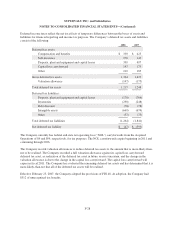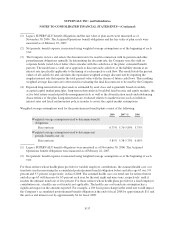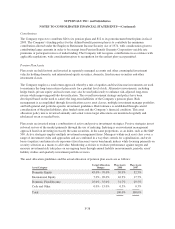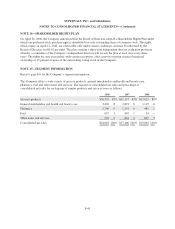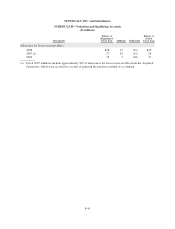Albertsons 2008 Annual Report Download - page 103
Download and view the complete annual report
Please find page 103 of the 2008 Albertsons annual report below. You can navigate through the pages in the report by either clicking on the pages listed below, or by using the keyword search tool below to find specific information within the annual report.
SUPERVALU INC. and Subsidiaries
NOTES TO CONSOLIDATED FINANCIAL STATEMENTS—(Continued)
(1) Legacy SUPERVALU benefit obligations and the fair value of plan assets were measured as of
November 30, 2006. The Acquired Operations benefit obligations and the fair value of plan assets were
measured as of February 22, 2007.
(2) Net periodic benefit expense is measured using weighted average assumptions as of the beginning of each
year.
(3) The Company reviews and selects the discount rate to be used in connection with its pension and other
postretirement obligations annually. In determining the discount rate, the Company uses the yield on
corporate bonds (rated AA or better) that coincides with the cash flows of the plans’ estimated benefit
payouts. The model uses a yield curve approach to discount each cash flow of the liability stream at an
interest rate specifically applicable to the timing of each respective cash flow. The model totals the present
values of all cash flows and calculates the equivalent weighted average discount rate by imputing the
singular interest rate that equates the total present value with the stream of future cash flows. This resulting
weighted average discount rate is then used in evaluating the final discount rate to be used by the Company.
(4) Expected long-term return on plan assets is estimated by asset class and is generally based on widely-
accepted capital market principles, long-term return analysis for global fixed income and equity markets, the
active total return-oriented portfolio management style as well as the diversification needs and rebalancing
characteristics of the plan. Long-term trends are evaluated relative to market factors such as inflation,
interest rates and fiscal and monetary polices in order to assess the capital market assumptions.
Weighted average assumptions used for the postretirement benefit plans consist of the following:
2008 2007 (1) 2006
Weighted average assumptions used to determine benefit
obligations:
Discount rate 6.75% 5.70-5.85% 5.75%
Weighted average assumptions used to determine net
periodic benefit cost: (2)
Discount rate 5.85% 5.38-5.75% 6.00%
(1) Legacy SUPERVALU benefit obligations were measured as of November 30, 2006. The Acquired
Operations benefit obligations were measured as of February 22, 2007.
(2) Net periodic benefit expense is measured using weighted average assumptions as of the beginning of each
year.
For those retirees whose health plans provide for variable employer contributions, the assumed health care cost
trend rate used in measuring the accumulated postretirement benefit obligation before and after age 65 was 9.0
percent and 9.5 percent, respectively, in fiscal 2008. The assumed health care cost trend rate for retirees before
and after age 65 will decrease by 0.5 percent each year for the next eight and nine years, respectively, until it
reaches the ultimate trend rate of five percent. For those retirees whose health plans provide for a fixed employer
contribution rate, a health care cost trend is not applicable. The health care cost trend rate assumption has a
significant impact on the amounts reported. For example, a 100 basis point change in the trend rate would impact
the Company’s accumulated postretirement benefit obligation at the end of fiscal 2008 by approximately $11 and
the service and interest cost by approximately $1 for fiscal 2009.
F-37



